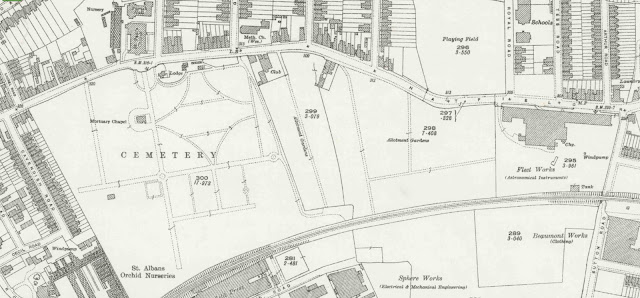While we can way find our way along Hatfield Road by means of the frontage shops, we now have a choice: the premises which line the south side of the road, and the occupier of the back land. We have reached the next of the fields owned by the St Albans Grammar School. Hertfordshire County Council planned a three-stage re-organisation of schools which had been a mix of board and elementary schools, which had themselves been borne from an earlier collection of British and National schools. One desperately urgent need was to separate senior pupils from infants and juniors to provide senior schools and distinct Junior Mixed and Infant Schools.
In 1925 Fleetville and Camp districts possessed no schools for senior children of either gender, and the council agreed to purchase a site of less than five acres for a pair of senior schools. Quite what it thought would fit on this acreage for two schools and its attendant playgrounds is debatable, quite apart from a playing field.
 |
| The 1924 map shows the cemetery and a large undeveloped space to its east. COURTESY NATIONAL LIBRARY OF SCOTLAND |
New premises was desperately needed for the school and for practical rooms which could be shared with elementary schools lacking in these facilities. So, new central school buildings came to Hatfield Road, and a search for a new pair of senior schools for the eastern districts would continue (and was eventually found at Oakwood Drive in 1938).
 |
| A cooking lesson in one of the practical classrooms. COURTESY JENNY BOLTON |
 |
| A typical HCC architectural design from the 1930s, of expanded buildings at Hatfield Road. COURTESY JENNY BOLTON |
 |
| Original handicraft and pupil teacher buildings, now unused on the site. |
Overcrowded Fleetville JMI school earnestly hoped the former girls' school buildings would be available for them, but the inadequate Beaumont schools, new in 1938, became a boy's secondary modern and its girls formed a new school in Hatfield Road, first as Beaumont Girls school, and then altering its name to Sandfield Girls to avoid the name Beaumont being used for two sites in different locations. All of this new accommodation was required for an increase in the leaving age to 15. Instead, Fleetville Overflow School was constructed in Oakwood Drive, being named Oakwood JMI School in 1958 when it opened.
 |
| Aerial view of the current school, playing field, ancillary buildings and the former Family Centre. COURTESY GOOGLE EARTH |
Fleetville Junior School is therefore the longest of the five occupiers of the buildings at forty-six years. The first two occupiers would even have experienced the occasional passing of a train on the southern boundary!


No comments:
Post a Comment